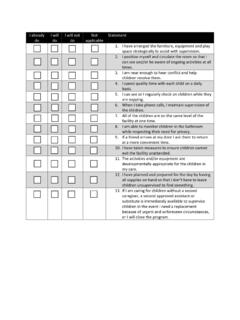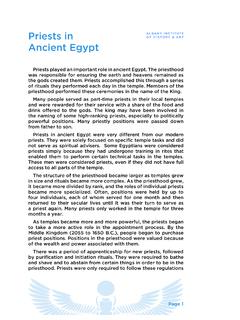Transcription of Confirmatory Factor Analysis with R - University at Albany, …
1 Confirmatory Factor Analysis with RA Draft document usinglavaan,sem, andOpenMxBruce Dudek2019-07-11 ContentsPreface31 Introduction and R Caveat on this document.. Resources..52 Prepare and Describe the The Data Set.. Numeric and Graphical Description of the Data.. Bivariate Characteristics of the data set.. Covariances and Zero Order Correlations..133 Using the lavaan package for Implement the CFA, First Model.. Generate a second model and compare.. Compare Model 1 and Model 2.. An additional perspective on estimation and optimization.
2 264 Using the sem package for Example one.. Example two.. Compare the two CFA models produced bysem..405 Using the OpenMx Package for First OpenMx Model - Single Factor .. SecondOpenMxModel - the bifactor model.. ThirdOpenMxModel.. Compare theOpenMxmodels..536 Summary and Reproducibility542 PrefaceThe data set and the models evaluated are those used by James Boswell in his APSY613 MultivariateAnalysis class in the Psychology Department at the University at albany . The data set is the WISC-R dataset that the multivariate statistics textbook by the Tabachnick textbook (Tabachnick et al.)
3 ,2019) employs forconfirmatory Factor Analysis illustration. The goal of this document is to outline rudiments of ConfirmatoryFactor Analysis strategies implmented with three different packages in R. The illustrations here attempt tomatch the approach taken by Boswell with SAS. The document is targeted to UAlbany graduate studentswho have already had instruction in R in their introducuctory statistics book/monograph uses thebookdownpackage (Xie,2018a) for R (R Core Team,2018), which wasbuilt on top ofrmarkdown(Allaire et al.
4 ,2018) andknitr(Xie,2015). RStudio (RStudio Team,2015)was used for all writing and 1 Introduction and R SetupThis short monograph outlines three approaches to implementing Confirmatory Factor Analysis with R,by using three separate packages. The illustration is simple, employing a 175 case data set of scores onsubsections of the WISC. The idea is to fit a bifactor model where the two latent factors are the verbal andperformance constructs. In this primary two- Factor model, each observed variable is associated with only onelatent Factor .
5 Then a second model is fit. It includes a path from both latent factors to one of the of models are then R packages are required for the implementations outlined in the succeeding chapters. Since CFAis implemented as a structural equation model, commercial software ( , LISREL, EQS, SAS) as well asopen-source approaches to CFA all use SEM routines. The three primary R packages to illustrate CFA arelavaan,semandOpenMx, along with the drawing package,semPlot. One major advantage of usingR for implementation of these methods is thatsemPlotprovides a user-friendly method for producingpath diagrams of many styles by simply taking a model object from the CFA fitting functions of the housekeeping packages are loaded here, but the three analytical packages for CFA are loaded atthe point in the sequence of their usage since some common function names are shared - thus load order (car)library(semPlot)library(psych)libra ry(knitr)library(kableExtra)library(MVN) library(dplyr)
6 Library(magrittr)library(tidyr)library(c orrplot)library(ggraph)Package citations for packages loaded here (in the above order):car(Fox et al.,2018),semPlot(Epskampand with contributions from Simon Stuber,2017),psych(Revelle,2019),knitr(X ie,2018b),kableExtra(Zhu,2019),MVN(Korkm az et al.,2018),dplyr(Wickham et al.,2018),magrittr(Bache and Wickham,2014),tidyr(Wickham and Henry,2018),corrplot(Wei and Simko,2017)Package citations for packages loaded elsewhere in this document:bookdown(Xie,2018a),rmarkdown(A llaire et al.,2018),sem(Fox et al.)
7 ,2017),lavaan(Rosseel,2018),OpenMx(Boker et al.,2019) CAVEAT ON THIS Caveat on this documentThe present treatment of the CFA procedures is not intended to be an exhaustive Analysis of this particulardata set. Nor is it intended to be a thorough treatment of the CFA approaches available in R, CFA ingeneral, or SEM in general. Rather, it is intended as a bit more than a simple introduction to CFA usingR (and by implication, the nice capabilities of for Structural Equation Modeling). It provides students, whohave a basic understanding of how to use R, with a reasonable introduction to CFA modeling code.
8 The Rappraoches can then be compared to their class coverage of the same Analysis , done with SAS. This documentprovides some capabilities that may not have been covered in class, and it misses others. The learning curvefor software is never at an ResourcesThe following list will provide a good start for those needing a broader in CFA modeling and more detailedsources for the primary packages empoyed in this document. A comprehensive textbook treatment of SEM and CFA: (Tabachnick et al.,2019) Tim Brown s well-regarded book on CFA: (Brown,2015) Rosseel s extensive original article on lavaan: (Rosseel,2012) El-Sheik, et al on a comparison of software for SEM: (El-Sheikh et al.)
9 ,2017) Narayanan s review of eight SEM software approaches (Narayanan,2012) Espkamp s helpful original article on thesemPlotpackage: (Narayanan,2012)In addition, the following internet resources can be helpful. Lavaan package home: [ ] Google Group for Lavaan: [ #!forum/lavaan] OpenMx package home: [ ] OpenMx package online forums: [ ] SEM package page on CRAN: [ ] lavaan package page on CRAN: [ ] OpenMx package page on Cran: [ ] MVN package page on Cran: [ ] semPlot package page on Cran: [ ]Chapter 2 Prepare and Describe the DataThis chapter prepares the data set and does some univariate and multivariate description of its characteristicsprior to the CFA implementation in later chapters.
10 Both numeric and graphical description and inferenceabout distribution shape are quickly available with R functions from The Data SetThe 175 case data set (no missing observations) is loaded from a .csv file. The .csv file was exported fromthe SPSS system file that is available from the website for the Tabachnick textbook (Tabachnick et al.,2019)It has eleven subscales from the WISC: info (Information) comp (Comprehension) arith (Arithmetic) simil (Similarities) vocab (Vocabulary) digit (Digit Span) pictcomp (Picture Completion) parang (Picture Arrangement) block (Block Design) object(Object Assembly) coding (Coding - not sure if it is A or B, or a combination)The user may recognize these scales as commonly discussed subtests of the WISC.



